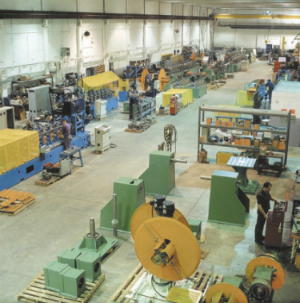
ERP upgrade keeps Samco in growth mode
by By Rebecca Reid
Company successfully implements CRM module; says employee buy-in is key to success.
TORONTO—When the recession hit a few years ago years ago, Samco Machinery Inc., a Toronto-based manufacturer of dies, presses and machinery for the roll forming industry, decided it had to adapt to changing business conditions and pursue markets beyond the US.
At the time, the US accounted for 80 per cent of its business. It needed to diversify, but the family-owned company—which grew from a small start-up in 1972—was facing a major obstacle in the form of outdated technology.
About three years ago, management decided to give the old ERP (enterprise resource planning) system the heave-ho.
“It’s done the job but it doesn’t have the capabilities like master scheduling or material requirements planning or capacity planning,” reflects Stephen Armstrong, chief innovation officer with Samco.
“When you scale a business, you have to scale the systems and the processes,” he adds. “You can’t rely on word-of-mouth and throw specs over the wall.”
For Samco, that meant replacing Infor’s ERP VISUAL with Microsoft Corp.’s Dynamics AX 2012—an ERP software suite with all the nuts and bolts such as integrated materials requirement planning (MRP) and customer relationship management (CRM).
Those tools are vital to supporting Samco’s engineer-to-order business. Since opening with 200 square-feet of rented office space 40 years ago, the company now occupies an 80,000 square-foot facility with two assembly areas, a CNC shop and tool room.
It employs 110 people and has operations in India and Europe. It supplies into such industries as building and construction, automotive and HVAC, and recently expanded in the solar power market with its new division, Samco Solar.
Samco is now working on its latest goals: to reach $100 million in revenue, continue to penetrate the solar power industry, and build a new rotary punch machine with speeds of 300 feet-per-minute (ft./min.) to 500 ft./min.
The new ERP system is key to supporting all the additional orders and complexities, says Armstrong. It connects data from various departments such as sales, inventory and customer service, for better visibility and planning.
It also integrates with Microsoft Office, creating a single system with reduced training costs.
Getting it done
AX-iom ERP Inc., an IT integration company with offices in Mississauga and Whitby, Ont. was brought in to guide the deployment of the new system.
AX-iom and Samco staff realized ERP systems can’t be implemented all at once. Each module must be brought on-line incrementally, to reduce the impact on day-to-day business.
AX-iom used Microsoft’s SureStep Methodology, a formal implementation procedure covering all the stages from initial analysis to go-live.
The CRM capabilities were implemented first because the materials planning and production modules require a lot of customization, fine- tuning and training. Problems with those modules at go-live might have shut the factory down, Armstrong says.
The CRM component launched in January 2012, and that’s when the company cancelled its subscription to Salesforce.com, a cloud-based CRM service, to take advantage of the benefits of having its client data tied in with its new ERP system.
Switching to Dynamics required Samco to bring its client data back in-house. One of the most time consuming phases of the project was cleaning the data, Armstrong notes.
Now the data resides on a Microsoft SQL Server, which integrates seamlessly with Dynamics.
Getting buy-in
From a change management point of view, the biggest challenge to the first module was convincing the employees to accept the new software, Armstrong says.
“Overall implementation [of CRM module] was six months and that had to do with our readiness. We did not want to go live until the people were fully engaged.”
After initial user training, Samco ran workshops half a day each week and asked employees to provide critiques of the procedures that were written by AX-iom.
“We put the ownership of the use of the system in the people’s hands,” he says.
The next phase of the implementation involves the operations and production components, which include building materials, project management and materials requirement planning (MRP).
But they aren’t going to roll all the functionality out at once, Armstrong explains. One of the biggest benefits of Dynamics is it can be programmed to emulate what you’re already doing and then gradually add the extra functionality, making it easier for employees to adapt.
The operations and production components were expected to be up and running in June 2012.
Overall, the project will have taken a year, but the benefits are already apparent. The CRM module includes estimating and quoting tools which reduce the manual effort required to respond to RFQs; helping the company win more business.
Customer and sales data is integrated with engineering and product development, leading to better visibility for planning and forecasting.
With the IT systems up to date, so is the company’s confidence. As orders come in from new markets and customers, managers know they’ve got the back end to keep up—and to keep growing.
